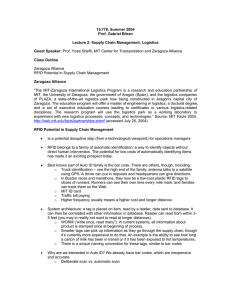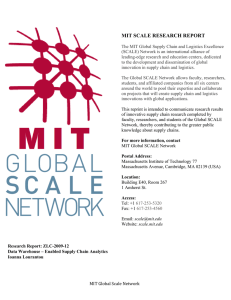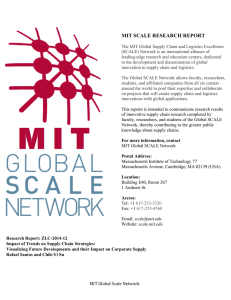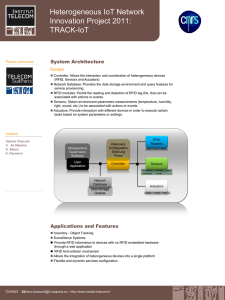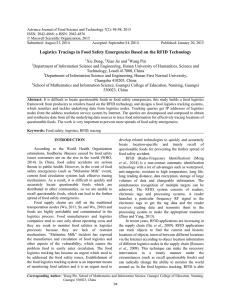MIT SCALE RESEARCH REPORT
advertisement
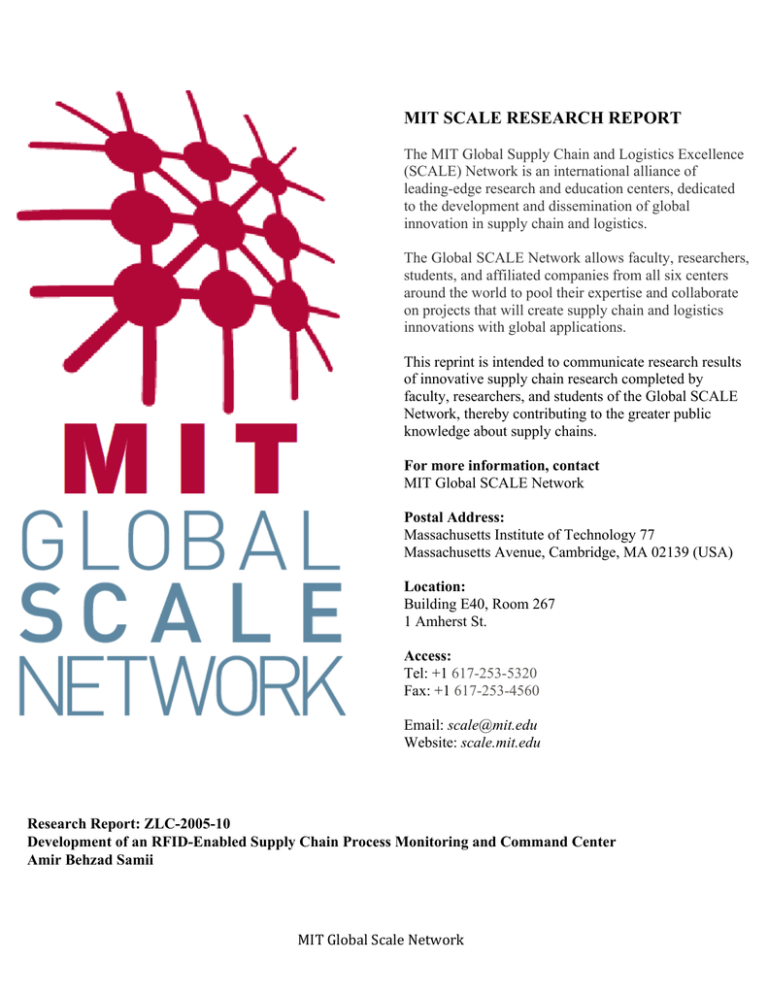
MIT SCALE RESEARCH REPORT The MIT Global Supply Chain and Logistics Excellence (SCALE) Network is an international alliance of leading-edge research and education centers, dedicated to the development and dissemination of global innovation in supply chain and logistics. The Global SCALE Network allows faculty, researchers, students, and affiliated companies from all six centers around the world to pool their expertise and collaborate on projects that will create supply chain and logistics innovations with global applications. This reprint is intended to communicate research results of innovative supply chain research completed by faculty, researchers, and students of the Global SCALE Network, thereby contributing to the greater public knowledge about supply chains. For more information, contact MIT Global SCALE Network Postal Address: Massachusetts Institute of Technology 77 Massachusetts Avenue, Cambridge, MA 02139 (USA) Location: Building E40, Room 267 1 Amherst St. Access: Tel: +1 617-253-5320 Fax: +1 617-253-4560 Email: scale@mit.edu Website: scale.mit.edu Research Report: ZLC-2005-10 Development of an RFID-Enabled Supply Chain Process Monitoring and Command Center Amir Behzad Samii MITGlobalScaleNetwork For Full Thesis Version Please Contact: Marta Romero ZLOG Director Zaragoza Logistics Center (ZLC) Edificio Náyade 5, C/Bari 55 – PLAZA 50197 Zaragoza, SPAIN Email: mromero@zlc.edu.es Telephone: +34 976 077 605 MITGlobalScaleNetwork DEVELOPMENT OF AN RFID-ENABLED SUPPLY CHAIN PROCESS MONITORING AND COMMAND CENTER By AMIR BEHZAD SAMII Submitted to the Zaragoza Logistics Center in Partial Fulfillment of the Requirements for the Degree of MASTER OF ENGINEERING IN LOGISTICS AND SUPPLY CHAIN MANAGEMENT In the MIT-ZARAGOZA INTERNATIONAL LOGISTICS PROGRAM At the ZARAGOZA LOGISTICS CENTER A RESEARCH INSTITUTE ASSOCIATED WITH THE UNIVERSITY OF ZARAGOZA EXECUTIVE SUMMARY In recent years, companies have been striving for increased visiblity and transparency of activities performed within (inter-organizational) supply chains. According to a survey conducted by Thonemann (2004), supply chain champion companies emphasize clear end-to-end planning processes, manage complexities actively, integrate their supply chain organization, and focus on operative coordination. Both in practice and in academia it is well acknowledged that increasing customer requirements in terms of reliability and responsiveness can only be met if processes in the supply chain can be monitored and controlled on a real-time basis. Real-time process monitoring requires that the states of relevant physical objects (e.g. containers, pallets, components) and information objects (e.g. customer orders, manufacturing orders) are captured individually after the performance of specific supply chain processes. The gathered information on object’s states can then be used to support a centralized or decentralized control of the processes in a supply chain. Process monitoring applications, which are currently being discussed are at best restricted to “alert generation”, i.e. a decision maker is notified if the state of an object deviates significantly from a pre-specified target state. More sophisticated applications could, however, include self-regulation mechanisms based on principles derived from cybernetics and system dynamics. If self-regulation is not feasible, intelligent mechanisms can be developed and implemented, which support decision makers by generating, evaluating and finally proposing feasible “repair mechanisms”. From a technological perspective, Radio Frequency IDentification (RFID) in association with other tracking and tracing technologies, e.g. GPS/GSM-based object location and barcode technology can be considered as enabler of command centers, which provide alert generation, self-regulation and intelligent decision support to decision makers in the supply chain. RFID is enabling technology for highly automated supply chain operations, including real-time process monitoring and decision support. Streamlined management of exceptions and improved visibility across all supply chain elements are the two major benefits of this technology. RFID technology could potentially disrupt existing barcode technology and eventually render it obsolete. However, one of the strongest barriers to acceptance of RFID so far has been the lack of software applications development. We propose an approach to process monitoring and control which utilizes real-time information obtained from an RFID system. We define a closed-loop control mechanism that identifies infeasible states of the process and, in addition to alert generation, triggers intelligent self-regulation and repair mechanisms. Based on a printer assembly line process, we define a model and corresponding algorithms of a prototype application to point out the potential of real-time process monitoring and control. This assembly line represents a micro supply chain. We assume the implementation of RFID at item-level and its implications on monitoring and control of assembly line processes. We construct a simplified model that assumes the assembly line as a single sequence of transitions and places without conditional branching. Then we capture the state of items from RFID tags and readers by combining the real-time EPC and reading zone locator data with the derived position-in-the-sequence locator data. The state of the system can be captured as the set of states of all items in the assembly line at any point in time. Consequently, feasibility or infeasibility of the system’s state is determined by comparing the captured state and the set of reference feasible states. This is the borderline between the process monitoring and the process control. We propose a closed-loop (feedback) control system. If the system’s state is infeasible we strive to obtain a feasible state by adequately instructing the system. This command can be in the form of swapping the position of items waiting in places for the next transition and give priority to the item with the least available slack time. An algorithm sorts the waiting items based on their available slack time and changes the position of the item in the sequence. In conclusion, we demonstrate an approach to RFID provided monitoring and control which can be the basis of further research in the fields of RFID software applications, RFID-enabled supply chain process monitoring, and RFID-enabled supply chain control. Thesis Supervisor: Dr. Richard Pibernik Professor of Supply Chain Management MIT-Zaragoza International Logistics Program
